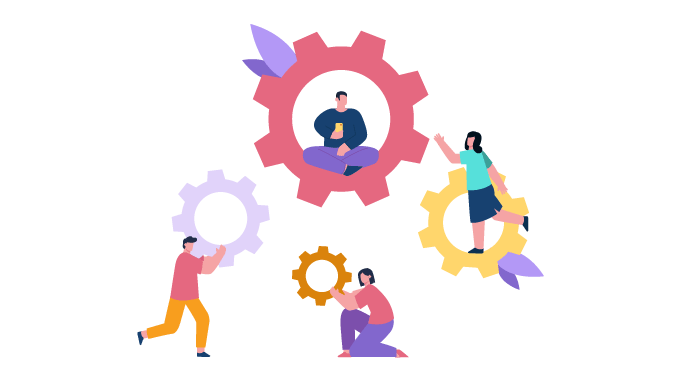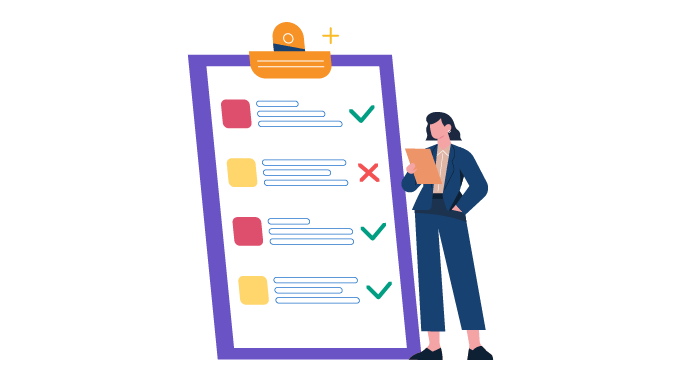Employee Retention Survey: All You Need To Know (+ Sample Questions)
According to the U.S. Bureau of Labor Statistics, an estimated 4 million people in America resign from their current job on a monthly basis.
Mastering the art of employee retention has become more crucial than ever. At the heart of this challenge lies the effective use of employee retention surveys. This article sheds light on how these surveys can be a game-changer for organizations seeking to understand and enhance their employee experience.
When employee retention survey questions are designed and implemented thoughtfully, it can help the organization understand the underlying causes and take necessary measures to stop employees from leaving.
Let's dive into the world of employee retention surveys, unveiling their potential to transform workplace dynamics and employee satisfaction.
Key Insights
- Concept of Employee Retention Surveys
- Types of Employee Retention Surveys
- Categories of Employee Retention Surveys
- Employee Retention Survey Questions
- How to implement employee retention surveys
- Analyzing and Using Employee Retention Survey Results
Understanding Employee Retention Surveys

What is an Employee Retention Survey?
An Employee Retention Survey is a strategic tool utilized by organizations to understand and analyze the factors contributing to employee job satisfaction and loyalty.
This survey encompasses various questions designed to extract insights about the employees' workplace experience, including -
- Job satisfaction,
- Career progression opportunities,
- Work environment, and
- Relationships with supervisors and peers.
The ultimate goal of such surveys is to identify strengths and areas of improvement within the organization, thereby aiding in the development of effective strategies to enhance employee engagement and reduce turnover. By regularly conducting these anonymous surveys, businesses can proactively address issues, fostering a supportive and productive work environment that encourages long-term employee retention.
Crafting Effective Employee Retention Survey Questions

Creating survey questions sounds simple, and it actually can be. However, you must know the types of questions that can be used to extract the maximum responses from your employees. Also, it is equally important to categorize the questions based on different requirements and criteria.
Types of Employee Retention Survey Questions
Likert Scale Questions:
These questions are structured to measure the degree of agreement or disagreement with a statement. They are highly effective for capturing the intensity of employees' feelings on specific issues.
Likert scale questions can reveal trends in employee satisfaction and are easy to analyze statistically.
Example:
On a scale of 1-5, how satisfied are you with your current role?
Open-Ended Questions:
These allow employees to provide detailed, narrative-style feedback. They are valuable for uncovering nuanced insights that structured questions might miss.
Open-ended questions can generate rich, qualitative data, but they require more time to analyze due to their varied nature.
Example:
What do you enjoy most about your job and why?
Multiple-Choice Questions:
These questions present employees with specific options to choose from. They are efficient for collecting standardized data and are easier to analyze than open-ended responses.
Multiple-choice questions work well for identifying common trends and preferences among employees.
Example:
Which of the following best describes your reason for staying with the company?
A) Salary, B) Work-Life Balance, C) Company Culture, D) Career Growth.
Rating Scale Questions:
These questions ask employees to rate aspects of their job experience on a numerical scale. They help quantify perceptions and compare different aspects of job experience.
Rating scales can be tailored to measure satisfaction, importance, frequency, and more.
Example:
On a scale of 1-10, how likely are you to recommend our company as a great place to work?
Binary Questions:
Binary questions, consisting of simple 'Yes/No' or 'True/False' options, are straightforward and easy for employees to answer. They are effective for gathering clear, concise data on specific, targeted issues.
Example:
Do you believe you have the tools and resources needed to perform your job effectively? Yes/No
So far, you attained a fair bit of understanding regarding the types of questions that can be used to craft a retention survey. Now, let’s move ahead to understand the next step, that is -
How to Categorize Employee Retention Survey Questions?
It is quite simple, actually. Categorization can be done based on the seven main pillars of employee retention. These pillars help an organization to create an engaging environment and maintain employee loyalty, satisfaction, and long-term commitment.
Let’s dive in to understand each category in detail and explore the 35 employee retention survey questions that will help you craft the best survey.
Job Satisfaction

This category delves deep into an employee's contentment with their role. Questions can range from satisfaction with daily tasks to the work environment and resources provided. Understanding job satisfaction is pivotal as it directly impacts an employee’s engagement and decision to stay.
Job satisfaction survey question examples:
- On a scale of 1-5, how satisfied do you feel with the variety of tasks in your job? [Likert-scale question]
- What aspects of your job do you find most fulfilling? [Open-ended questions]
- What factor most contributes to your job satisfaction? [Multiple Choice Question]
A) Work environment, B) Type of work, C) Colleagues and team dynamics, D) Autonomy in role - How would you rate the level of support you receive for your tasks, on a scale of 1-10? [Rating scale questions]
- Do you have the necessary tools to perform your job effectively? Yes/No [Binary Questions]
Career Development

These questions focus on how employees view their growth opportunities within the organization. They reveal whether employees feel they have clear career paths, access to training, and support for professional development.
Career development survey question examples:
- On a scale of 1-5, how accessible are the training and resources needed to succeed in your role? [Likert-scale questions]
- How can the organization better support your professional growth? [Open-ended questions]
- What aspect of career development is most important to you? [Multiple Choice Question]
A) Training opportunities, B) Promotion prospects, C) Skill development, D) Mentorship programs - Rate the quality of professional development programs available to you, on a scale of 1-10. [Rating scale questions]
- Do you believe the company supports your career goals? Yes/No [Binary Questions]
According to Deloitte, organizations with a robust learning culture experience 30% to 50% higher engagement and retention rates.
Management and Leadership

Here, the focus is on the relationship between employees and their managers. It includes inquiries about the effectiveness of communication, support from leadership, and the quality of managerial feedback. Good leadership is often a cornerstone of high employee retention rates.
Management and leadership survey question examples:
- On a scale of 1-5, how trustworthy is the leadership team at our company? [Likert-scale question]
- What qualities do you value in the company's leadership? [Open-ended questions]
- What quality do you value most in your manager? [Multiple Choice Question]
A) Communication skills, B) Supportiveness, C) Decision-making ability, D) Trustworthiness - Rate the effectiveness of communication from your manager on a scale of 1-10. [Rating scale questions]
- Do you trust the leadership team of the company? Yes/No [Binary Questions]
Work-Life Balance

The work-life balance category assesses how effectively employees can balance their professional obligations with their personal lives. Questions might cover aspects like workload, flexibility of work hours, and support for personal commitments.
Work-life balance survey question examples:
- On a scale of 1-5, how comfortable do you feel using the allotted personal and vacation time? [Likert-scale]
- What flexible work options would be most beneficial for you? [Open-ended questions]
- Which aspect of work-life balance do you prioritize the most? [Multiple Choice Question]
A) Flexible working hours B) Remote work options C) Paid time off D) Workload management - Rate the flexibility of your work schedule on a scale of 1-10. [Rating scale questions]
- Do you find your workload manageable? Yes/No [Binary Questions]
Company Culture and Values

These questions are aimed at understanding how well employees resonate with the company's culture and core values. A strong, positive culture often translates into higher employee loyalty.
Company Culture and Values survey question examples:
- On a scale of 1-5, how proud are you to be part of this organization? [Likert-scale questions]
- In what ways does the company culture impact your daily work? [Open-ended questions]
- What aspect of company culture do you find most appealing? [Multiple Choice Question]
A) Team collaboration, B) Innovation and creativity, C) Diversity and inclusion, D) Social responsibility - Rate the company’s commitment to ethical practices on a scale of 1-10. [Rating scale questions]
- Do you feel aligned with the company's core values? Yes/No [Binary Questions]
Compensation and Benefits

This section evaluates how satisfied employees are with their compensation, benefits, and other perks. It's important for companies to know if their packages are competitive and fair in the market.
Compensation and Benefits survey question examples:
- On a scale of 1-5, how fair is your compensation compared to industry standards? [Likert-scale questions]
- How do benefits influence your decision to stay with the company? [Open-ended questions]
- Which factor in your compensation package do you value the most? [Multiple Choice Question]
A) Base salary, B) Health benefits, C) Retirement plans, D) Performance bonuses - Rate your satisfaction with your current salary and compensation on a scale of 1-10. [Rating scale questions]
- Is the company's bonus structure motivating for you? Yes/No [Binary Questions]
Feedback and Recognition

It's about understanding how recognized and valued employees feel in their roles. This category covers the frequency and quality of feedback, recognition programs, and how achievements are celebrated.
Feedback and Recognition survey question examples:
- On a scale of 1-5, how frequently do you receive recognition for a job well done? [Likert-scale]
- What achievements are you most proud of in your role? [Open-ended questions]
- What form of recognition do you prefer the most? [Multiple Choice Question]
A) Public acknowledgment, B) Financial rewards, C) Professional development opportunities, D) Personalized feedback - Rate how well the company celebrates individual and team achievements, on a scale of 1-10. [Rating scale questions]
- Do you feel valued for your contributions? Yes/No [Binary Questions]
Recommended Read: 60 Employee Engagement Survey Questions You Must Ask In 2024
Implementing Employee Retention Surveys

The implementation process for an employee retention survey is not different from any other survey. It follows the same standard process, starting from defining the objectives to taking action and following up on those actions.
Let’s have a quick glance at the entire process.
1. Define Clear Objectives
Determine specific areas to focus on, such as work environment, management, or career development opportunities. This helps tailor the survey to address key issues within your organization.
2. Design the Survey Thoughtfully
Create a balanced mix of question types. For instance, use Likert scales for measuring levels of satisfaction, open-ended questions for detailed insights, and binary questions for straightforward feedback. Ensure the survey is not too long to prevent survey fatigue.
3. Communicate the Purpose
Explain to employees why the survey is being conducted and how their feedback will be used. This can be done through team meetings, emails, or internal newsletters. Transparency encourages more honest and thoughtful responses.
4. Guarantee Anonymity
Use platforms that ensure respondent anonymity to encourage openness. Make it clear that responses cannot be traced back to individuals.
5. Choose the Right Platform
Opt for a user-friendly survey tool that is accessible to all employees. Consider mobile compatibility if employees are often on the go.
6. Analyzing the Results
Dedicate time to thoroughly analyze the data. Look for trends, common themes, and areas with particularly high or low scores. Consider using data visualization tools for clearer insights.
7. Take Action and Follow-up
Develop a clear plan based on the survey results. Address the concerns raised and communicate what steps will be taken. Schedule follow-up surveys or meetings to discuss progress and ongoing concerns.
Analyzing and Using Employee Retention Survey Results

Using employee retention survey data effectively is a critical step in understanding and improving your workplace dynamics. Here’s how you can make the most of this valuable information -
Prioritize the Important Issues through some In-Depth Analysis
Begin by thoroughly examining the survey responses. Look for patterns or specific feedback in crucial areas like job satisfaction, management relationships, and work-life balance. This analysis will highlight key areas that need attention.
Next, you need to identify and prioritize the most pressing issues based on their potential impact on employee retention. Focus on areas where improvements can make a significant difference in employee morale and engagement.
Develop Targeted Action Plans Through Collaborative Solution
For each identified issue, create a detailed action plan. This might include revising company policies, introducing new training programs, or launching initiatives aimed at improving certain aspects of the workplace.
The best way to implement an action plan is by involving employees in the solution-building process. Conduct workshops, focus groups, or team meetings to bring employees on the same page regarding the solutions.
By engaging employees, you gather diverse perspectives and foster a sense of ownership and inclusion.
Implement and Communicate Changes
Once the action plan is created, roll out the changes strategically and ensure that the changes are communicated clearly to all employees.
It is equally important that employees know and understand the reasons behind changes. This step is crucial for ensuring that the workforce understands and supports the new initiatives.
Maintain the Feedback Loop
As employees understand the new changes and accept them, encourage them to provide feedback based on those changes. Be prepared to make adjustments as necessary based on continuous feedback and the organization's evolving needs. It is also your responsibility to regularly review the effectiveness of the implemented changes.
According to Tinypulse Retention Reports, employees who feel uncomfortable providing upward feedback are 16% less likely to remain with their current employer.
Therefore, you must keep the communication channels open. Regularly update employees on the progress being made and adjustments implemented in response to their feedback. This transparency builds trust and shows employees that their opinions are valued and acted upon.
Final Words
Employee retention surveys are not just a metric; they are a roadmap for organizational growth and employee fulfillment. They offer invaluable insights into the employee psyche, guiding leaders to make impactful decisions.
By tapping into the feedback from these surveys, companies can cultivate a workplace that not only retains talent but also nurtures it. The journey of understanding and acting on employee feedback is an ongoing one, but it is undoubtedly a journey worth embarking on for any forward-thinking organization.


















